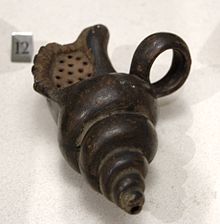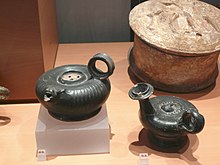Guttus

In classical archeology, a form of Greek ceramics is called guttus (plural gutti , from gutta = drop) .

In ancient Greece, a guttus was a vessel for pouring liquids drop by drop. It was made of various materials and was used as a sacrificial jug when dispensing liquids and for pouring out small amounts of oil or water. The exact shape and appearance of the vessel named with the Latin term have not been handed down, but in modern archeology the term is associated with a small can-shaped jug with half a handle and a small, short tubular spout attached to the upper edge. In general, these are Hellenistic-Lower-Italian narrow-necked donation cans, in which oil was probably kept. They have a ring handle on the back and are often decorated with a relief image in the middle of the back. The pouring spout generally has a trumpet-shaped mouth. Figurative forms are also known.
Gutti is also said to be early feeding bottles for artificial baby feeding. The oldest existing gutti are now in the Muzeul de Istorie Națională și Arheologie Constanța in Piazza Ovid . Gutti are described in Heinrich Brüning's book on the history of artificial infant feeding, but not as old as those from the Museum of Constancea. They date from the 1st to 3rd centuries AD.
literature
- Heinrich Brüning: History of the methodology of the artificial infant feeding. After studying medicine, culture and art history. Enke, Stuttgart 1908.
- Walter Hatto Groß : Guttus. In: The Little Pauly . Volume 2: Dicta Catonis to Iuno. Druckmüller, Stuttgart 1967, column 884.
- Wolfgang Schiering : The Greek clay pots. Shape, purpose and change of form (= Gebr.-Mann-Studio-series ). 2nd, significantly changed and expanded edition. Mann, Berlin 1983, ISBN 3-7861-1325-4 , pp. 143f.